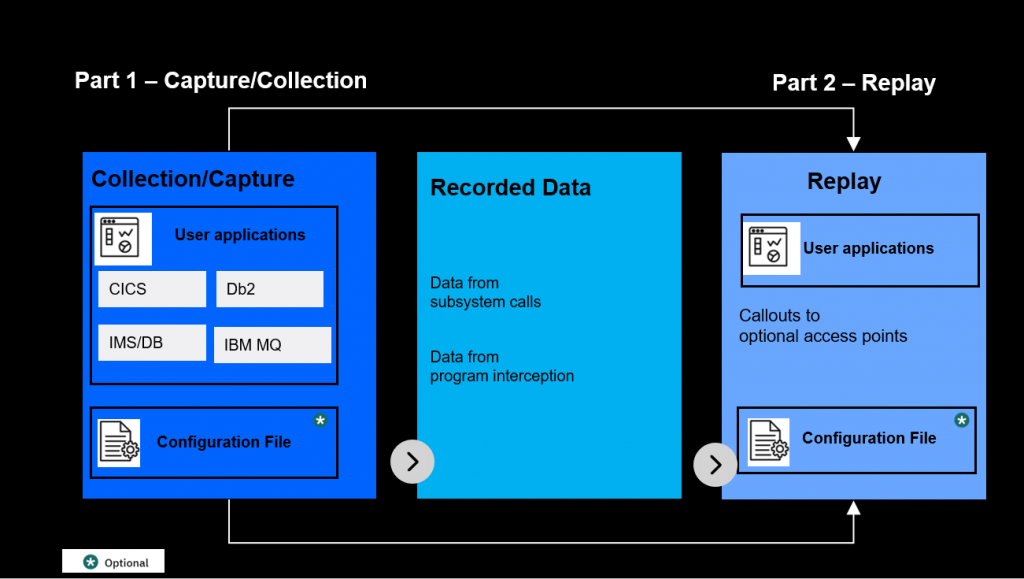
We are delighted and proud to announce the general availability of
IBM Wazi Virtual Test Platform (Wazi VTP) V1.0.0.
Shift-left testing and test automation are key to identifying defects early in the software development lifecycle and to deliver quality software at speed. An agile DevOps strategy cannot succeed if it leaves testing to be done too late in the process and requires the tests to be executed manually. With Wazi VTP, we are all set to transform testing on Z by providing both shift left and test automation capabilities.
Wazi VTP provides the capability to perform fully virtualized transaction level testing. This capability further allows integration with CI/CD process enabling test automation, effectively shifting-left your application Integration Testing!
How does Wazi VTP work?A high-level overview of Wazi Virtual Test Platform includes two parts: collection and replay. The collection process creates and saves data that can be later used for replay

Neither collection nor replay require any changes to user applications (COBOL, PL/1 or Assembler). Applications are executed as is, without the need for recompilation, relinking, or rebinding. This process doesn’t even need a debugger, all you’ll need are the user’s original load modules.
Wazi VTP intercepts calls made by application programs to various subsystems or other programs and records details about those calls. Once this data is recorded, those same user application programs can be rerun in batch, without the need for the original test environment or data. Everything can be fed back to the values from the recorded data. This feature allows for an automated testing process of online transactions and batch programs, whether testing a one or a thousand transactions. Additionally, the application programs can be modified with desired changes and then rerun to help ensure they perform without adverse effects.
Let’s put this into context by discussing a few high-level scenarios:A developer makes a change to a program. Traditionally a change would be made, built, and deployed into QA systems and only then would testing begin. But testing too late once code has been deployed continues to be a key challenge and major inhibitor to a smooth release cycle. IBM meets that challenge head on, shifting unit testing to the left, with the introduction of ZUnit.
What is Unit Testing?Unit testing is a paradigm where the smallest piece of code or program, that can be practically isolated, is tested. This capability empowers developers to test any change in isolation.
But is Unit testing prior to code deployment enough QA for the system?
While Unit testing helps developers make code changes confidently, it’s still possible that this change can have a cascading impact on other programs called by a transaction. Are you going to wait for the code to be deployed into target sub-system to test the transactions?
Jeff Douglas, lead developer of Wazi Virtual Test Platform, and the team thinks not. “We are now fundamentally changing the way testing will be done in the future by shifting- left application integration, transactional and batch testing.”
Developers can now record transactions through a CICS terminal or an API and create a playback file that can later be used to replay the transactions in batch mode. There’s no longer a need for the original CICS environment or data, thus enabling the first stage of integration testing. These tests can also be included as part of an automated build process, enabling test automation through continuous integration and continuous deployment (CI/CD).
You can even record and test your batch jobs by simply adding the Wazi VTP load library as part of steplib in the JCL. Once recorded, the test can be executed in far less time than the original batch job since it runs against recorded data without the need for original middleware.
But we’re not done yet. Are you planning for a compiler upgrade, SCM Migration, or ABO implementation and wondering how to test? Are testing efforts during migration more taxing than the migration itself? Wazi VTP can remove these burdens by providing the capability to record transactions and batch jobs before the upgrade. You can then execute these transactions against the rebuilt or optimized modules to test the behaviour, which simplifies your Regression Testing.
Finally, Wazi VTP does not mandate any additional z/OS or client software. The platform doesn’t require any vendor specific software, like debuggers or problem determination tooling. Embarking on a transformation of this magnitude has never been easier!
Would you like to know more? Watch this
demo.
We just provided a very high-level overview of what Wazi VTP can do, but it has so much more. Refer to our
product documentation for further details.
Read what analysts have to say –
Big Blue adds shift-left support Give us a call and let’s partner in your transformation journey!